About Mysore
Mysore or Mysuru, is the third largest city in Karnataka. The city was ruled by the Wodeyar dynasty and it is well known for the rich architectural history, palaces, and beautiful gardens. It is located at the bottom of the Chamundi Hills and is about 150 kms from Bangalore.The city has a large tourism industry, which attracts tourists from all across the World. The city is famous for the palaces, the delicious Pak and the Dashara celebration in the city. It is one of the most visited destinations in Karnataka.
DAY 1 PICKUP FROM BANGALORE: Hotel /Airport / Railway Station / Bus Station and proceed to Mysore Local Sightseeing places including:
CHAMUNDI HILL TEMPLE
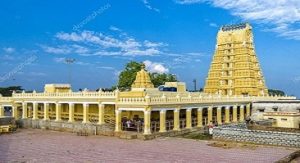 Chamundi Hill is very famous for Chamundeswari temple dedicated to Goddess Chamundeswari, an incarnation of Goddess Parvathi who took this form to destroy Mahishasura. Also known as Krouncha Pitham, Chamundi Temple is one among the 18 Maha Shakti Peethas representing the hair of Sati Devi and among the prime place to visit on a Mysore trip. This is one of the major pilgrimage sites in Karnataka and one of the top places to visit in Mysore.At an altitude of 1065 meters, the temple on Chamundi Hill was built in 11th century. For centuries, the Wodeyars of Mysore revered the deity and made extensive contributions to this shrine. The idol of goddess Chamundi inside the central sanctum was made with pure gold. The temple is a fine example of Dravidian temple architecture. The temple possesses lots of images of Nandi. The most famous is the 15 feet high and 24 feet long Nandi on the 800th step on the hill.
Chamundi Hill is very famous for Chamundeswari temple dedicated to Goddess Chamundeswari, an incarnation of Goddess Parvathi who took this form to destroy Mahishasura. Also known as Krouncha Pitham, Chamundi Temple is one among the 18 Maha Shakti Peethas representing the hair of Sati Devi and among the prime place to visit on a Mysore trip. This is one of the major pilgrimage sites in Karnataka and one of the top places to visit in Mysore.At an altitude of 1065 meters, the temple on Chamundi Hill was built in 11th century. For centuries, the Wodeyars of Mysore revered the deity and made extensive contributions to this shrine. The idol of goddess Chamundi inside the central sanctum was made with pure gold. The temple is a fine example of Dravidian temple architecture. The temple possesses lots of images of Nandi. The most famous is the 15 feet high and 24 feet long Nandi on the 800th step on the hill.
MYSORE PALACE
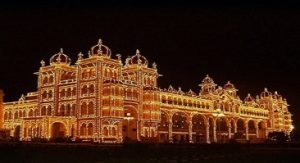 The architectural style of the palace is commonly described as Indo-Saracenic and blends together Hindu, Muslim, Rajput and Gothic styles of architecture. It is a three-storied stone structure, with marble domes and a 145 ft five-storied tower. The palace is surrounded by a large garden. The facade has seven expansive arches and two smaller ones flanking the central arch, which is supported by tall pillars. Above the central arch is an impressive sculpture of Goddess Gajalakshmi with her elephants.
The architectural style of the palace is commonly described as Indo-Saracenic and blends together Hindu, Muslim, Rajput and Gothic styles of architecture. It is a three-storied stone structure, with marble domes and a 145 ft five-storied tower. The palace is surrounded by a large garden. The facade has seven expansive arches and two smaller ones flanking the central arch, which is supported by tall pillars. Above the central arch is an impressive sculpture of Goddess Gajalakshmi with her elephants.
JAGAN MOHAN PALACE / JAYACHAMARAJENDRA ART GALLERY
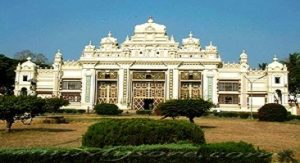 The Palace is a three-storied structure constructed in traditional Hindu style of architecture. The original palace was extended in 1900 and an external facade with a hall was added to the existing structure of the palace. This new facade has three entrances. The walls of the interiors are painted with murals. These mural paintings which follow the traditional style of the Mysore school of painting depict the Dussehra scene and the canvas depicting the sequence of the Jumboo Savari stretches across three walls. A family tree of the Wodeyars tracing the lineage of the royal family is also painted on a wall. Two wooden displaying Dashavatara, the ten incarnations of the Lord Vishnu is also present in the palace. Until the completion of the main palace auditorium in 1912, the annual day and Dussehra festival celebrations were taken place here.
The Palace is a three-storied structure constructed in traditional Hindu style of architecture. The original palace was extended in 1900 and an external facade with a hall was added to the existing structure of the palace. This new facade has three entrances. The walls of the interiors are painted with murals. These mural paintings which follow the traditional style of the Mysore school of painting depict the Dussehra scene and the canvas depicting the sequence of the Jumboo Savari stretches across three walls. A family tree of the Wodeyars tracing the lineage of the royal family is also painted on a wall. Two wooden displaying Dashavatara, the ten incarnations of the Lord Vishnu is also present in the palace. Until the completion of the main palace auditorium in 1912, the annual day and Dussehra festival celebrations were taken place here.
ST. PHILOMENA’S CATHEDRAL
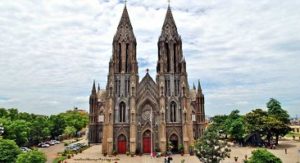 The church is dedicated to 3rd century saint Philomena who was the daughter of the monarch of a small state in Greece. Her parents were childless for several years. They prayed Jesus to bless them with a child and the next year Philomena was born to them. Even in her childhood Philomena showed signs of piety. When Philomena was 13 years old her father took her to Rome to obtain the favour of Emperor Diocletian. The Emperor was enthralled by her beauty and wanted to marry her. But she refused and vowed to give herself to God. She was tortured and beheaded in Rome. But people’s devotion for her spread near and far and she was given sainthood.
The church is dedicated to 3rd century saint Philomena who was the daughter of the monarch of a small state in Greece. Her parents were childless for several years. They prayed Jesus to bless them with a child and the next year Philomena was born to them. Even in her childhood Philomena showed signs of piety. When Philomena was 13 years old her father took her to Rome to obtain the favour of Emperor Diocletian. The Emperor was enthralled by her beauty and wanted to marry her. But she refused and vowed to give herself to God. She was tortured and beheaded in Rome. But people’s devotion for her spread near and far and she was given sainthood.
BRINDAVAN GARDENS
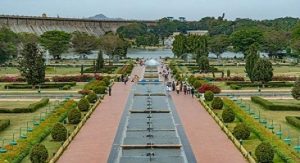 The garden was designed by Sir Mirza Ismail, Diwan of Mysore based on Shalimar Gardens of Kashmir in the Mughal style. Spread over an area of 150 acres, the Brindavan Gardens is considered as one of the best gardens in India. The garden is enriched with fountains, terraces, parterres, running and cascading water channels, lush green lawns & flower beds.The Musical and dancing fountain, located in the North Brindavan Garden, is the main attraction of the garden. The best time to visit the gardens is after sunset when all the bright colourful fountains come alive. The garden also has a wonderful palace in southern park which is now converted to a 4-star luxery hotel called Royal Orchid.
The garden was designed by Sir Mirza Ismail, Diwan of Mysore based on Shalimar Gardens of Kashmir in the Mughal style. Spread over an area of 150 acres, the Brindavan Gardens is considered as one of the best gardens in India. The garden is enriched with fountains, terraces, parterres, running and cascading water channels, lush green lawns & flower beds.The Musical and dancing fountain, located in the North Brindavan Garden, is the main attraction of the garden. The best time to visit the gardens is after sunset when all the bright colourful fountains come alive. The garden also has a wonderful palace in southern park which is now converted to a 4-star luxery hotel called Royal Orchid.
Drop at Mysore Hotel / Over Night Stay In Mysore End of a One Day Mysore Local Sightseeing Tour…
Itinerary for Day 2 Coorg Sigtseeing Tour
About Coorg
Coorg, officially called Kodagu, is the most sought after and popular hill station of Karnataka. Lying serenely amidst high mountains, Coorg’s landscape stays misty throughout the year. The aboriginals of the place are Kodavas. Apart from Kannada, the other two main languages of this hill station are Kodagu and Kodava.The best time to visit Kodagu is between October to May and the peak season for this hill station is within February to May. Kodagu is the largest producer of Coffee in India. Also, it is one of the places with highest rainfall across the nation. Undulating hills covered in lush green forests and a landscape dotted with coffee plantations, tea gardens and orange groves, this hill station has breathtakingly stunning scenic beauty.
DAY 2 PICKUP FROM MYSORE: Hotel / After Brakefast Chekout and proceed Coorg Sightseeing places including:
TALACAUVERY / TALAKAVERI
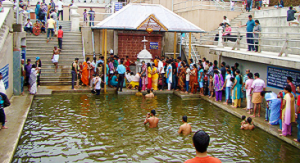 At Talacauvery, there is a square tank called Cauvery Kundike or Brahma Kundike, which is considered to be the birth place of River Cauvery. Here, River Cauvery emerges as a perennial spring and disappears underground. River Cauvery again emerges at Nagathirtha near Bhagamandala and joins with Kannike and Sujyoti at Triveni Sangam. Bhagamandala is the meeting of three rivers and is also referred to as Triveni Sangam.According to legend, Cauvery was held captive by sage Agasthya in a Kamandala, a pot carrying sacred water. Lord Ganesha in the form of a crow made the Kamandala to topple at this hill when Sage Agasthya was meditating. There is a shrine dedicated to Kaveri Amman near the kundike and a big tank in front of it where devotees baths before offering prayers. The temple was renovated by the state government in 2007.
At Talacauvery, there is a square tank called Cauvery Kundike or Brahma Kundike, which is considered to be the birth place of River Cauvery. Here, River Cauvery emerges as a perennial spring and disappears underground. River Cauvery again emerges at Nagathirtha near Bhagamandala and joins with Kannike and Sujyoti at Triveni Sangam. Bhagamandala is the meeting of three rivers and is also referred to as Triveni Sangam.According to legend, Cauvery was held captive by sage Agasthya in a Kamandala, a pot carrying sacred water. Lord Ganesha in the form of a crow made the Kamandala to topple at this hill when Sage Agasthya was meditating. There is a shrine dedicated to Kaveri Amman near the kundike and a big tank in front of it where devotees baths before offering prayers. The temple was renovated by the state government in 2007.
BHAGAMANDALA
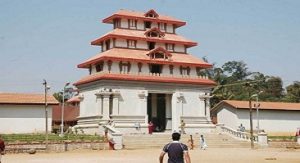 Bhagamandala is situated at the confluence of two rivers, the Cauvery and the Kannike. A third river, the Sujyothi is said to join from underground. It is well known as Triveni Sangama and also considered as Dakshina Kashi. It is a common practice for pilgrims to take a dip in the sangama and perform rituals to their ancestors before proceeding to Talacauvery, the birthplace of Kaveri River. During 1785-1790, the area was occupied by Tipu Sultan and he renamed it as Afesalabad. Then in 1790 King Dodda Veerarajendra took Bhagamandala back into an independent Kodagu.
Bhagamandala is situated at the confluence of two rivers, the Cauvery and the Kannike. A third river, the Sujyothi is said to join from underground. It is well known as Triveni Sangama and also considered as Dakshina Kashi. It is a common practice for pilgrims to take a dip in the sangama and perform rituals to their ancestors before proceeding to Talacauvery, the birthplace of Kaveri River. During 1785-1790, the area was occupied by Tipu Sultan and he renamed it as Afesalabad. Then in 1790 King Dodda Veerarajendra took Bhagamandala back into an independent Kodagu.
RAJA’S SEAT
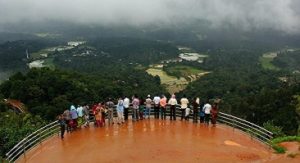 The Raja’s Seat, which means the Seat of Kings, is a brick and mortar structure with four pillars connected by arches. It is built on a high elevation with a commanding view of the cliffs and valleys. This lovely spot was once a favorite place of recreation for the King of Coorg. He used to spend time with his queen in the garden and watching the setting sun. The spot offers a breathtaking view of towering hills, green valleys studded with paddy fields. It is fascinating to watch the road to Mangalore like a curved ribbon lying in the valley.
The Raja’s Seat, which means the Seat of Kings, is a brick and mortar structure with four pillars connected by arches. It is built on a high elevation with a commanding view of the cliffs and valleys. This lovely spot was once a favorite place of recreation for the King of Coorg. He used to spend time with his queen in the garden and watching the setting sun. The spot offers a breathtaking view of towering hills, green valleys studded with paddy fields. It is fascinating to watch the road to Mangalore like a curved ribbon lying in the valley.
ABBEY FALLS
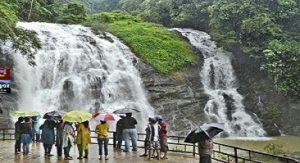 British called Abbey Waterfalls as Jessy waterfalls in memory of Jessy, the daughter of Madikeri’s first British Captain Chaplain. Abbey Falls is situated in the middle of a private coffee plantations and spice estates. Numerous small streams and abundant rainfall combine to form the Abbey Waterfalls. It is one of the best waterfalls in Coorg region. This waterfall flows to unite with the River Cauvery. Abbey Falls cascades down the rocky slopes from a height of 70 feet into a pool. A hanging bridge has been built across the gorge here, from where the visitors can get a beautiful view of the falls. The sound of the waterfalls can be heard from the main road during the rainy season. A Kali Mata temple on the other side of the bridge is also not to be missed. The path leading to the waterfalls is filled with thick vegetation and offers wonderful experience.
British called Abbey Waterfalls as Jessy waterfalls in memory of Jessy, the daughter of Madikeri’s first British Captain Chaplain. Abbey Falls is situated in the middle of a private coffee plantations and spice estates. Numerous small streams and abundant rainfall combine to form the Abbey Waterfalls. It is one of the best waterfalls in Coorg region. This waterfall flows to unite with the River Cauvery. Abbey Falls cascades down the rocky slopes from a height of 70 feet into a pool. A hanging bridge has been built across the gorge here, from where the visitors can get a beautiful view of the falls. The sound of the waterfalls can be heard from the main road during the rainy season. A Kali Mata temple on the other side of the bridge is also not to be missed. The path leading to the waterfalls is filled with thick vegetation and offers wonderful experience.
MADIKERI FORT
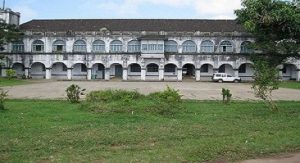 Madikeri Fort was first built by Mudduraja, the then king of Coorg, in the last quarter of the 17th century AD. The king had also constructed a mud palace inside the fort premises. The fort was built as a mud structure and was rebuilt in stone by Tipu Sultan in 1781 AD and named the site as Jaffarabad. In 1790 AD, Dodda Veerarajendra took control of the fort. The fort faced further changes and renovations during the period 1812 – 1814 AD when it came under the rule of Lingarajendra Wodeyar II. In 1834 AD the fort was captured by the British.
Madikeri Fort was first built by Mudduraja, the then king of Coorg, in the last quarter of the 17th century AD. The king had also constructed a mud palace inside the fort premises. The fort was built as a mud structure and was rebuilt in stone by Tipu Sultan in 1781 AD and named the site as Jaffarabad. In 1790 AD, Dodda Veerarajendra took control of the fort. The fort faced further changes and renovations during the period 1812 – 1814 AD when it came under the rule of Lingarajendra Wodeyar II. In 1834 AD the fort was captured by the British.
OMKARESWARA TEMPLE
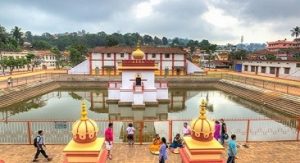 Dedicated to Lord Shiva, Omkareshwara Temple was built by Lingarajendra in 1820 CE. The Shivalinga installed inside the temple is believed to be brought from Kashi. According to the legend, the king had killed a pious Brahmin to fulfill his political ambitions. However, the king started to have nightmares for his cruel deed. In order to free himself from the nightmares, the King sought the advice of a few wise men and they told the king to build a temple of Lord Shiva to regain his mental peace. The king followed their advice and brought a Shiva lingam from the holy town of Kashi and installed it at a newly constructed temple. The Shivalinga was named as Omkareshwara and regular rituals were performed.
Dedicated to Lord Shiva, Omkareshwara Temple was built by Lingarajendra in 1820 CE. The Shivalinga installed inside the temple is believed to be brought from Kashi. According to the legend, the king had killed a pious Brahmin to fulfill his political ambitions. However, the king started to have nightmares for his cruel deed. In order to free himself from the nightmares, the King sought the advice of a few wise men and they told the king to build a temple of Lord Shiva to regain his mental peace. The king followed their advice and brought a Shiva lingam from the holy town of Kashi and installed it at a newly constructed temple. The Shivalinga was named as Omkareshwara and regular rituals were performed.
Drop at Coorg Hotel / Over Night Stay In Coorg End of a Day 2 Coorg Local Sightseeing Tour…
Itinerary for Day 3 Coorg Sigtseeing Tour
DAY 3 PICKUP FROM COORG: Hotel / After Brakefast and Chekout proceed Coorg Sightseeing places including:
DUBARE ELEPHANT CAMP
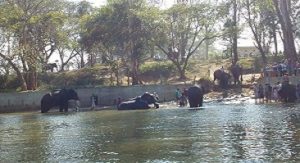 Dubare is an important base for the Karnataka Forest Department’s elephants. Dubare Elephant Camp is a project undertaken by forest department and jungle lodges & resorts. This camp has plenty of elephants which are trained under naturalists. The elephants used for Mysore Dussehra are trained at this camp. The trainers explain the various aspects of elephant history, ecology and biology. Visitors can also participate in various activities involving elephants like feeding the elephants with ragi, jaggery, sugarcane, banana and coconuts. Tourists can also watch elephants being given a scrub-bath in the river and also watch how oil is applied on their forehead, tusks etc.
Dubare is an important base for the Karnataka Forest Department’s elephants. Dubare Elephant Camp is a project undertaken by forest department and jungle lodges & resorts. This camp has plenty of elephants which are trained under naturalists. The elephants used for Mysore Dussehra are trained at this camp. The trainers explain the various aspects of elephant history, ecology and biology. Visitors can also participate in various activities involving elephants like feeding the elephants with ragi, jaggery, sugarcane, banana and coconuts. Tourists can also watch elephants being given a scrub-bath in the river and also watch how oil is applied on their forehead, tusks etc.
CAUVERY NISARGADHAMA
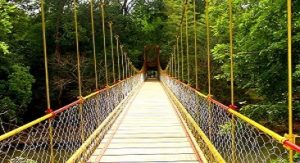 This island was developed as tourist spot in 1988 by the Forest Department. Spread over a sprawling 64-acre land, the island is filled with thick bamboo groves, sandalwood and teak trees. The island is accessible through a hanging rope bridge. This island also features deer park, Rabbit Park, Peacock Park and Orchidarium. The Island is perfect for a picnic with the children. It is also an ideal destination for those who love nature and spend time by themselves. It is very good site for seeing parakeets, bee eaters and woodpeckers and a variety of butterflies.
This island was developed as tourist spot in 1988 by the Forest Department. Spread over a sprawling 64-acre land, the island is filled with thick bamboo groves, sandalwood and teak trees. The island is accessible through a hanging rope bridge. This island also features deer park, Rabbit Park, Peacock Park and Orchidarium. The Island is perfect for a picnic with the children. It is also an ideal destination for those who love nature and spend time by themselves. It is very good site for seeing parakeets, bee eaters and woodpeckers and a variety of butterflies.
GOLDEN TEMPLE / TIBETAN MONASTERY
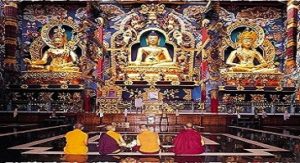 Bylakuppe is a Tibetan refugee settlement area established by Lugsum Samdupling in 1961 and Dickyi Larsoe in 1969 and is situated to the west of Mysore district close to Bangalore – Coorg route. The main tourist attraction here is the magnificent Namdroling Monastery. Popularly called as Golden Temple, the Namdroling Monastery was established by Drubwang Padma Norbu Rinpoche in 1963. This is the largest teaching center of Nyingmapa, a lineage of Tibetan Buddhism, in the world and is home to a sangha community of over 5000 monks and nuns.
Bylakuppe is a Tibetan refugee settlement area established by Lugsum Samdupling in 1961 and Dickyi Larsoe in 1969 and is situated to the west of Mysore district close to Bangalore – Coorg route. The main tourist attraction here is the magnificent Namdroling Monastery. Popularly called as Golden Temple, the Namdroling Monastery was established by Drubwang Padma Norbu Rinpoche in 1963. This is the largest teaching center of Nyingmapa, a lineage of Tibetan Buddhism, in the world and is home to a sangha community of over 5000 monks and nuns.
Drop at Bangalore Hotel / Over Night Stay In Bangalore End of a Day 3 Coorg Local Sightseeing Tour…
Itinerary for Day 4 Bangalore Sigtseeing Tour
About Bangalore
Legend has it that King Veeraballa of Vijayanagara once lost his way in a forest. Hungry and exhausted, he chanced upon an old woman cooking outside a hut. He begged her for food and was given a bowl of baked beans or ‘benda kallu’ in Kannada. The king’s gratitude was so immense that he named the place after the dish. Hence the region came to be known as ‘Benda Kallu Ooru’, or ‘Land of baked beans’ which eventually became Bangalore.Bangalore (Bengaluru), also known as the Silicon Valley of the south, is a perfect example of peaceful coexistence. Recent years have seen Bengaluru develop and grow exponentially, while staying true to its roots. Despite its gradual metamorphosis into a concrete jungle filled with corporates and high-end pubs, Bengaluru remains a tourist hub with several million tourists flocking to see the various sights in and around the city every year.
DAY 4 PICKUP FROM BANGALORE: Hotel / After Brakefast Chekout and proceed Bangalore Sightseeing places including:
BULL TEMPLE / BASAVANAGUDI NANDI TEMPLE
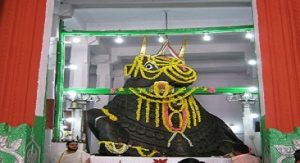 Bull Temple also known as Basavanagudi Nandi Temple is situated on top of a hill at Basavanagudi. This Hindu temple is situated inside a park called Bugle Rock. The temple is dedicated to sacred bull Nandi, the vehicle of Lord Shiva. This is one of the oldest temples of Bangalore and also one of the top pilgrimages & tourist attractions in Bangalore city.The temple was built in 1537 by Kempegowda in Dravidian style. The temple is relatively small in size, but houses one of the largest monolithic Nandi statues in the world which measures 4.5 meter in height and 6 meter in length. The temple also houses the idols of God Surya and Chandra, on their chariots. A 17th century inscription at the base of the structure mentions about a stream called Vrishabhavathi that originated here. The tower over the shrine was constructed in early 20th century and is adorned with figures of gods and motifs.
Bull Temple also known as Basavanagudi Nandi Temple is situated on top of a hill at Basavanagudi. This Hindu temple is situated inside a park called Bugle Rock. The temple is dedicated to sacred bull Nandi, the vehicle of Lord Shiva. This is one of the oldest temples of Bangalore and also one of the top pilgrimages & tourist attractions in Bangalore city.The temple was built in 1537 by Kempegowda in Dravidian style. The temple is relatively small in size, but houses one of the largest monolithic Nandi statues in the world which measures 4.5 meter in height and 6 meter in length. The temple also houses the idols of God Surya and Chandra, on their chariots. A 17th century inscription at the base of the structure mentions about a stream called Vrishabhavathi that originated here. The tower over the shrine was constructed in early 20th century and is adorned with figures of gods and motifs.
DODDA GANAPATHI TEMPLE
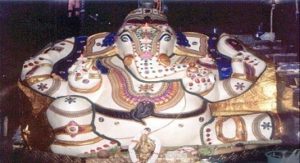 Dodda Ganapathi Temple or Basavanagudi Ganesh Temple is located on the Bull Temple Road in Basavanagudi. Built in 1971, the temple has a monolithic statue of Lord Ganesha with 18ft in height and 16ft in width. It is one of the popular pilgrimage & tourist attraction in Bangalore.The deity in this temple is also known as Shakthi Ganapathi or Satya Ganapathi. The idol is believed to be growing on its right side. The most popular ceremony of the temple is the butter coating which apparently consumes about 100 kg of butter. This butter is broken up and distributed to the devotees once in every four years. This is a spectacular sight at the temple and a visit to the temple to witness this is recommended.
Dodda Ganapathi Temple or Basavanagudi Ganesh Temple is located on the Bull Temple Road in Basavanagudi. Built in 1971, the temple has a monolithic statue of Lord Ganesha with 18ft in height and 16ft in width. It is one of the popular pilgrimage & tourist attraction in Bangalore.The deity in this temple is also known as Shakthi Ganapathi or Satya Ganapathi. The idol is believed to be growing on its right side. The most popular ceremony of the temple is the butter coating which apparently consumes about 100 kg of butter. This butter is broken up and distributed to the devotees once in every four years. This is a spectacular sight at the temple and a visit to the temple to witness this is recommended.
TIPU SULTHAN’S PALACE
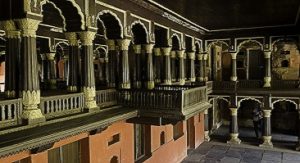 The Summer Palace is an example of Indo-Islamic architecture. The entire palace is built of teak wood, mortar, stone and plaster. It is laid on a stone plinth. The structure is two-storied and is supported by wooden pillars that rest on the stone base. The exquisitely carved pillars support giant wooden beams that hold the structure. It is believed that Tipu Sultan used to conduct his durbar from the upper floor of the palace. The upper chambers and balconies can be accessed by four staircases with the central portion being a large hall that leads to four smaller rooms. These rooms are considered to be women’s quarters. Beautiful floral motifs enhance the walls and the ceilings of the palace.
The Summer Palace is an example of Indo-Islamic architecture. The entire palace is built of teak wood, mortar, stone and plaster. It is laid on a stone plinth. The structure is two-storied and is supported by wooden pillars that rest on the stone base. The exquisitely carved pillars support giant wooden beams that hold the structure. It is believed that Tipu Sultan used to conduct his durbar from the upper floor of the palace. The upper chambers and balconies can be accessed by four staircases with the central portion being a large hall that leads to four smaller rooms. These rooms are considered to be women’s quarters. Beautiful floral motifs enhance the walls and the ceilings of the palace.
VISWESWARAIAH INDUSTRIAL & TECHNOLOGICAL MUSEUM
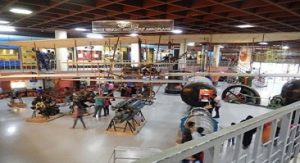 The museum occupies an area of 4000 sq. m, housing various industrial products and engines, which were opened by Sri Pandit Jawaharlal Nehru in 1962. The first gallery set up at VITM on the theme Electricity was opened to the public in 1965. An airplane and a steam engine are displayed in its compound.VITM has 7 permanent exhibition galleries titled Engine Hall, Fun Science, Electro technic, Space – Emerging Technology in the Service of Mankind, Biotechnological Revolution, BEL Hall of Electronics and Children Science. The Engine Hall exhibits engines of various automobiles, machines used in industry, a jet aircraft engine and other mechanical devices. The Electro Technic Gallery contains interactive electrical exhibits which work on the basic principles of electricity, electronics and communication. The Fun Science gallery exhibits the sciences of sound, optics, fluids and perception.
The museum occupies an area of 4000 sq. m, housing various industrial products and engines, which were opened by Sri Pandit Jawaharlal Nehru in 1962. The first gallery set up at VITM on the theme Electricity was opened to the public in 1965. An airplane and a steam engine are displayed in its compound.VITM has 7 permanent exhibition galleries titled Engine Hall, Fun Science, Electro technic, Space – Emerging Technology in the Service of Mankind, Biotechnological Revolution, BEL Hall of Electronics and Children Science. The Engine Hall exhibits engines of various automobiles, machines used in industry, a jet aircraft engine and other mechanical devices. The Electro Technic Gallery contains interactive electrical exhibits which work on the basic principles of electricity, electronics and communication. The Fun Science gallery exhibits the sciences of sound, optics, fluids and perception.
THE GOVT. MUSEUM
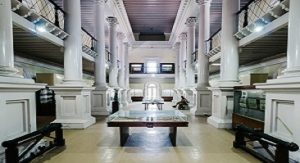 Government Museum is located at the Kasturba Gandhi Road, quite near to the Cubbon Park. Established in 1886, it is one of the oldest museums in India. It is also known as State Archeological Museum. With great collection of artifacts, it’s one of the ideal places to visit in Bangalore for history & art lovers.There are 18 galleries showcasing a rich collection of coins, art and relics from the Mohenjodaro, Halebid and Vijayanagara. It also houses the relics dating back to 5000 years. The painting gallery includes beautiful and rare paintings in Mysore and Tanjore style and also paintings from Rajasthani and Pahari schools. The museum also preserves antiques that date back to the civilization of Harappa and Mohenjodaro. Among the other artifacts on display, ivory carvings, inlay work, sandal-wood caskets are highly appreciated.
Government Museum is located at the Kasturba Gandhi Road, quite near to the Cubbon Park. Established in 1886, it is one of the oldest museums in India. It is also known as State Archeological Museum. With great collection of artifacts, it’s one of the ideal places to visit in Bangalore for history & art lovers.There are 18 galleries showcasing a rich collection of coins, art and relics from the Mohenjodaro, Halebid and Vijayanagara. It also houses the relics dating back to 5000 years. The painting gallery includes beautiful and rare paintings in Mysore and Tanjore style and also paintings from Rajasthani and Pahari schools. The museum also preserves antiques that date back to the civilization of Harappa and Mohenjodaro. Among the other artifacts on display, ivory carvings, inlay work, sandal-wood caskets are highly appreciated.
LALBAGH BOTANICAL GARDENS
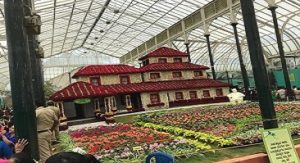 The ruler of Mysore, Hyder Ali commissioned the development of the garden in 1760. Initially designed in Mughal style, this garden was further developed by Hyder Ali’s son Tipu Sultan. Sprawling over an area of 240 acres, there are more than 1,800 species of flora, including plants, shrubs and trees, most of them from outside India. The garden attained status of a Government Botanical Garden in 1856. The garden surrounds one of the towers erected by Kempe Gowda. The park has some rare species of plants brought from Persia, Afghanistan and France. With an intricate watering system for irrigation, this garden is aesthetically designed with lawns, flowerbeds, lotus pools and fountains. The Lalbagh Rock, one of the oldest rock formations on earth dating back to 3,000 million years, is another attraction.
The ruler of Mysore, Hyder Ali commissioned the development of the garden in 1760. Initially designed in Mughal style, this garden was further developed by Hyder Ali’s son Tipu Sultan. Sprawling over an area of 240 acres, there are more than 1,800 species of flora, including plants, shrubs and trees, most of them from outside India. The garden attained status of a Government Botanical Garden in 1856. The garden surrounds one of the towers erected by Kempe Gowda. The park has some rare species of plants brought from Persia, Afghanistan and France. With an intricate watering system for irrigation, this garden is aesthetically designed with lawns, flowerbeds, lotus pools and fountains. The Lalbagh Rock, one of the oldest rock formations on earth dating back to 3,000 million years, is another attraction.
Drop at Bangalore Hotel / Airport / Railway Station / Bus Station. End of a 4 days Bangalore to Mysore Coorg & Bangalore Local Sightseeing Tour
[Four Days Tour Car Rental Tariffs]
| Sl.No. | Cab Type | Per Day Non Ac | Per Day A/c | Add Km | Add Hrs | Parking Extra |
| 1 | Indica | Rs 1,400/- | Rs 1,600/- | Rs 08/- | Rs 150/- | Yes |
| 2 | Toyota Etios | Rs 1,800/- | Rs 2,100/- | Rs 10/- | Rs 200/- | Yes |
| 3 | Tavera | Rs 2,100/- | Rs 2,400/- | Rs 12/- | Rs 250/- | Yes |
| 4 | Innova | Rs 2,600/- | Rs 2,900/- | Rs 14/- | Rs 300/- | Yes |
| 5 | Tempo Traveller 12 + 1 Seater | Rs 4,200/- | Rs 4,600/- | Rs 16/- | Rs 400/- | Yes |
| 6 | Mini Bus 20 + 1 seater | Rs 5,200/- | Rs 5,600/- | Rs 26/- | Rs 400/- | Yes |
Guests are requested to follow the itinerary provided in the 4 Days Bangalore To Mysore Coorg & Bangalore Local Sightseeing tour package. This 4 days Karnataka tour package can not be customized, however if guests prefer to visit different set of places in Karnataka and around, they can create their own itinerary and request for a custom quote from cab providers.
